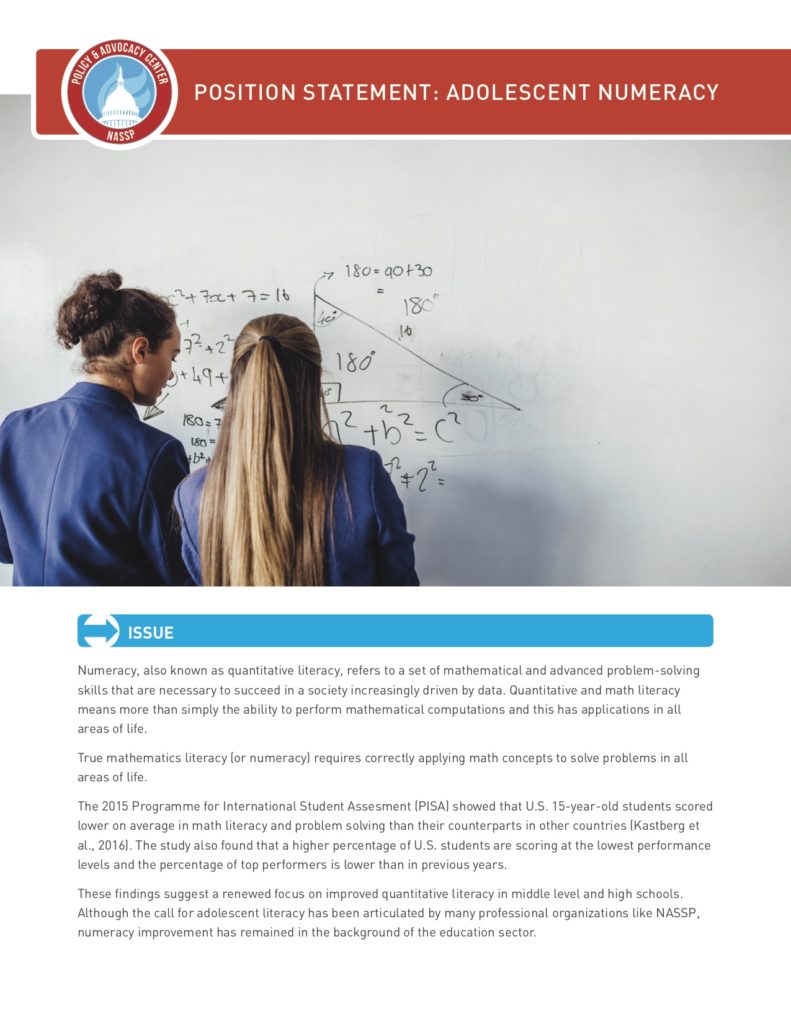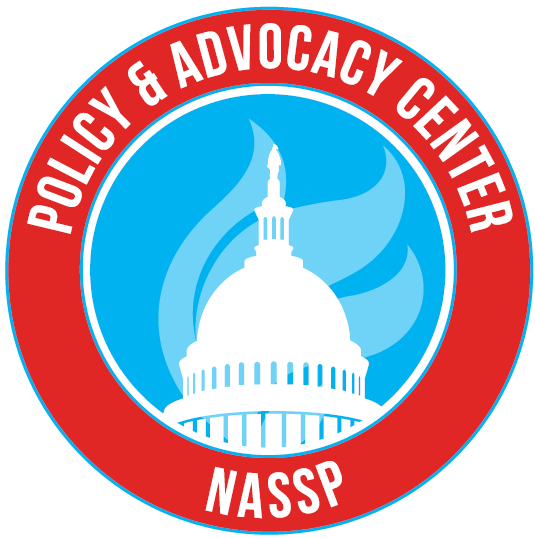Numeracy, also known as quantitative literacy, refers to a set of mathematical and advanced problem-solving skills that are necessary to succeed in a society increasingly driven by data. Quantitative and math literacy means more than simply the ability to perform mathematical computations and this has applications in all areas of life.
True mathematics literacy (or numeracy) requires correctly applying math concepts to solve problems in all areas of life.
The 2015 Programme for International Student Assesment (PISA) showed that U.S. 15-year-old students scored lower on average in math literacy and problem solving than their counterparts in other countries (Kastberg et al., 2016). The study also found that a higher percentage of U.S. students are scoring at the lowest performance levels and the percentage of top performers is lower than in previous years.
These findings suggest a renewed focus on improved quantitative literacy in middle level and high schools. Although the call for adolescent literacy has been articulated by many professional organizations like NASSP, numeracy improvement has remained in the background of the education sector.
Recent findings continue to demonstrate the past failures to stress the importance of numeracy, as U.S. adults are still trailing their international counterparts (National Center for Education Statistics, 2016). Educators must place a larger focus on numeracy if they’re to ensure that today’s students do not fall behind in the global scale. Not only will students see great benefits from an enhanced understanding of numeracy, but the American economy could do so as well. If the United States were able to perform at one of the higher levels of the international spectrum, the economic returns for workers could be significant, including potential wage shifts and a decline in unemployment (Peterson, 2013).
The importance of proper numeracy skills has now come to the forefront of the American economy. The American workforce is changing quickly. American workforce skills, particularly in occupations providing a living wage, are keeping pace with increased employment demands in science, technology, engineering, and math (STEM). The current STEM workforce can range from five to twenty percent of all U.S. workers depending on one’s definition of STEM (Larson & Xue, 2015). Three-quarters of the fastest growing occupations require significant mathematics or science preparation, including numeracy (Adecco Group, 2016). STEM occupations have been growing so quickly that there are not enough individuals with the necessary skills to fill these positions. “For every two open STEM job listings, there is only one qualified unemployed individual” (Adecco Group, 2016). Unless more focus is placed on the importance of numeracy, these STEM job gaps will only continue to increase. “Economic projections point to a need for approximately one million more STEM professionals than the U.S. will produce at the current rate over the next decade if the country hopes to retain its historical preeminence in science and technology” (President’s Council of Advisors on Science and Technology, 2012).
Standardized assessment scores also show as reading comprehension scores improve, so do assessment scores in mathematics. It is important to remember that many middle level and high school teachers often do not perceive that mastery of mathematics content standards that must be supported by cross-content applications and is within their professional responsibilities.
Guiding Principles
- NASSP is committed to being a major voice in supporting K-12 numeracy.
- NASSP is committed to providing professional development resources and advocacy for middle level and high school leaders in their efforts to address adolescent numeracy.
- NASSP is committed to evaluating programs and providing school leaders with resources to implement research-based, schoolwide adolescent numeracy programs and initiatives.
- NASSP is committed to providing all students with equitable educational opportunities, regardless of their language, cultural background, race, or socioeconomic status.
- NASSP believes that mathematics is not an intellectual sieve but a life skill whose successful application is required of all students in real-world situations.
- NASSP believes in the whole-school approach to numeracy and believes that all secondary teachers are responsible for teaching the mathematics skills and concepts inherent in their content area.
- NASSP advocates effective teaching of mathematics concepts in grades preK-12 and along the postsecondary continuum.
- NASSP believes that numeracy must be a focused effort, supported by local, district, state, and federal resources.
Recommendations for Federal Policymakers
- Appropriate adequate funds for Title IV of the Every Student Succeeds Act to promote using technology as a resource for students to extend and reinforce mathematical concepts.
- Appropriate adequate funds for cross-content curriculum development and teacher training.
Recommendations for State Policymakers
- Commit adequate resources to making mathematics numeracy a priority in middle level and high schools. Increased resources must also be made available to students who have not reached proficiency in mathematics.
- Encourage families and communities to make mathematics instruction a priority and set high expectations for all mathematics students.
- Provide teachers and principals with ample opportunities to broaden and refresh their mathematics preparation and to investigate how mathematical content is related to technology and everyday applications.
- Engage community, business and university leaders, who recognize the importance of hiring employees who can think critically and solve problems, in reinforcing the efforts of their local schools by providing improved career educational and occupational opportunities for students with strong mathematics instruction.
Recommendations
Recommendations for District Leaders
- Rather than punish low-performing schools, work with the school improvement team to develop a school plan that prioritizes areas of improvement based on the results of a comprehensive needs assessment and capacity analysis.
- Provide ongoing intensive technical assistance and related support to low-performing schools.
- Focus efforts on attracting and retaining highly effective teachers and school leaders in low-performing schools, and provide all educators with extensive job-embedded professional development opportunities.
- Ensure that school leaders in low-performing schools have autonomies over their calendars, staffing, budgets, and curricular decisions.
- Provide schools with timely performance information that allows them to make adjustments during the school year.
- Publish information about school and district report cards in a way that is easily understood by parents and community members.
Recommendations for School Leaders
- Invest themselves in all aspects of planning, implementing, and monitoring a schoolwide numeracy program. This includes forming leadership teams, developing a schoolwide plan for teachers and students, and establishing a staff development plan supported by district personnel.
- Encourage partnerships with community business and university leaders in providing real world experiences built from mathematics literacy.
- Staff mathematics classrooms with highly qualified teachers. Challenge and support girls, minority students, and students of lower socioeconomic status, who are currently underrepresented in AP mathematics courses. Encourage school principals, in collaboration with school mathematics personnel, to identify mathematics content standards to be reinforced by teachers in other content areas. Teachers and administrators must set and meet mathematics standards in every teacher’s classroom. Offer preservice and inservice mathematics teachers standards-based techniques that support classroom problem solving and that use technology in the context of real-life situations. Reinforce the notion that mathematics is a tool that can be used in all content areas.
- Promote the addition of “arts” in STEM so it is then STEAM, thus helping students see the real life application of the creative thinking and design skills they develop throughout their education in the hard sciences.
Resources
Feldman, Anna. “Why We Need To Put The Arts Into STEM Education”. Slate Magazine. N.p., 2017. Web. 9 Feb. 2017.
Infographic: STEM Skills Are Driving Innovation. Adeccousacom. 2016. Available at: https://www.adeccousa.com/employers/resources/infographic-stem-skills-are-driving-innovation/. Accessed December 21, 2016.
Kastberg D, Ying Chan J, Murray G, Gonzales P. Performance Of U.S. 15-Year-Old Students In Science, Reading, And Mathematics pteracy In An International Context. Washington, DC: National Center for Education Statistics; 2016.
Peterson P. U.S. Adults Perform Below International Average in Numeracy, pteracy and Problem Solving. 2013. Available at: https://educationnext.org/. Accessed December 21, 2016.
President’s Council of Advisors on Science and Technology, Engage to excel: producing one milpon additional college graduates with degrees in science, technology, engineering, and mathematics (Executive Office of the President of the United States, 2012).
Rampey B, Finnegan R, Goodman M et al. Skills Of The U.S. Unemployed, Young, And Older Adults In Sharper Focus: Results From The Program For The International Assessment Of Adult Competencies (PIAAC) 2012/2014. Washington, DC; 2016:5-8.
Xue YLarson R. STEM crisis or STEM surplus? Yes and yes. Monthly Labor Review. 2015. Available at: https://www.bls.gov/opub/mlr/2015/article/stem-crisis-or-stem-surplus-yes-and-yes.htm. Accessed December 21, 2016.


